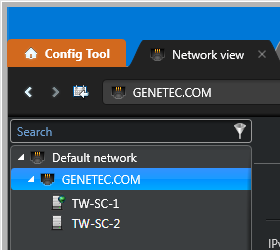The network entity is used to capture the characteristics of the networks used by your system so that proper stream routing decisions can be made.
Unless your entire system runs from a single private network without communicating with the outside world, you must configure at least one network entity other than the Default network to describe your networking environment.
How network entities are created
Network entities are created automatically by the system.
- The Default network is the root node on the network tree. Its video transmission capabilities are set to Unicast TCP, which is the characteristic shared by all IP networks. You cannot delete the Default network entity.
- A second network entity attached to the Default network, that corresponds to your company’s network (where your main server is located).

After that, more network entities are added to your system when you add new servers belonging to different networks.
When a server with multiple network interface cards (NIC) is added to the system, only the first address defined in the operating system is represented by default as a network entity. However, you can add the other network entities manually, if later, you need to have a better control of the routing capabilities.
A federated network (![]() ) is created for every federated system. It allows
you to control how media from that system is accessed from the local system, to force media
redirection, and to set the route capabilities.
) is created for every federated system. It allows
you to control how media from that system is accessed from the local system, to force media
redirection, and to set the route capabilities.
Network routes
Between every two networks on your system there is a route. The data transmission capabilities of the route are limited to the smallest capability set of the two end points.
For example, if one end is capable of multicast and the other end is only capable of unicast UDP, the capabilities of the route between these two end points cannot be more than unicast UDP.
If the connection between the two end points (for example VPN) only supports unicast TCP, you might have to further limit the capabilities of a route.
